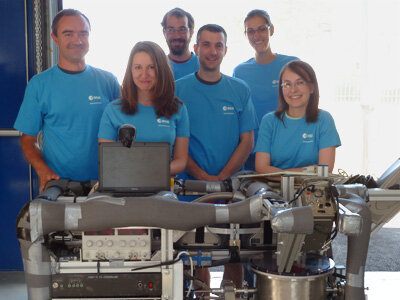Meet the teams
Four teams of postgraduate students flew their experiments during the 2011 'Fly Your Thesis!' campaign. Here is an introduction to the French team.
![]()
Supermassive B. team – Deep Impact![]()
![]()
| Universities | Joseph Fourier University (Grenoble) and Paul Sabatier University (Toulouse), France |
| Endorsing professor |
Dr. Jean-Charles Augereau Observatoire de Grenoble |
| Assistant engineer |
Jérôme Giraud Joseph Fourier University |
| ELGRA mentor |
Dr. Thomas Podgorski Joseph Fourier University |
| Team |
Audrey Grockowiak Rémi De Guiran Magali Dugué Laurianne Palin |

This student experiment is related to the modeling and understanding of dust production due to asteroid collisions in late debris discs (i. e. orbiting fields of planetesimals, rock, ice and dust), in order to improve theoretical and numerical models that relate the dust observed around stars to the existence of large bodies like exoplanets, which are much more difficult to observe directly.
The aim of this experiment is, therefore, to study the dust resulting from collisions between a projectile and a target made of compacted dust, as a simulation of colliding asteroids. The experimental parameters focused on by the team are: the dust production rate, its size distribution and the velocity field of the dust produced by the impact.
The student team performed collisions between two simulated asteroids (sample and impactor) and observed the resulting ejection of smaller bodies. They studied objects of a particular chemical composition on each of the three parabolic flights. Using the microgravity environment, they performed a statistical analysis of the impact parameters.

In preparation for the flights, the students simulated samples with spheres of compacted dust. They probed three types of powder: home-ground peridotite, from a rock gathered in Massif Central, and simulated martian and lunar regolith. The impactors were small metallic or glassy spheres. The samples and impactors were stored separately in barrel-like, rotating storage systems, facing each other on opposite sides of the collision chamber.
During the flight, they performed one collision per parabola: at the beginning of the microgravity phase, pistons pushed one sample and one impactor towards each other at a given velocity, ranging between 1 and 10 m/s. The students will collected the required data by filming each collision. They will analyze the films with point tracking software to obtain statistical data on the collisions.
The main goal of this research is to obtain new sets of data to improve the current models of asteroid collision simulations, since most of them do not take into account the velocity field of the ejecta and are based on data for only one type of material.
Read more about this experiment on the ERASMUS Experiment Archive.



